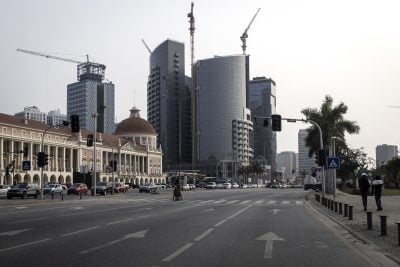Take a journey through any African city and it’s clear that the continent is permanently on the move.
Minibuses crammed with commuters weave manically through traffic, pickup trucks overflow perilously with construction workers, and decades-old Japanese taxis spew diesel fumes among roadside vendors.
Despite this sense of constant, exhilarating motion, the unfortunate reality is that African countries continue to suffer from rudimentary transport systems defined by dilapidated roads and outdated vehicle models long since abandoned in the rest of the world. Vehicle ownership remains the preserve of the few – according to Deloitte, in 2014 there were just over 42.5m registered vehicles in use in Africa, a continent of approximately 1bn people.
The continent’s motorisation rate of just 44 vehicles per 1,000 inhabitants that year, versus a global average of 182, hinted at the profound underdevelopment of the automotive market and manufacturing base in large swathes of Africa. With the exception of new vehicles built in the established hubs of North and South Africa, most of the continent makes do with imports of dubious quality from the developed world.
But that picture could soon be about to change.
In January, German automotive giant VW – already active in South Africa – announced that it will begin assembling vehicles at a new plant in Rwanda in May. The firm says that their $20m initial investment will offer new cars to compete with second-hand imports, and will enable the firm to launch a ride-sharing service in a country where Uber has yet to make its mark.
By producing the Hatchback Polo, the Passat, and possibly the Teramont, a sports utility vehicle, the firm aims to initially create up to 1,000 jobs, according to Reuters. “We are trying to break this pattern that Africa is poor; they can’t afford (new) cars,” Thomas Schaefer, chief executive of the firm’s South African operations, told a press conference.
Growing markets
VW’s move capitalises on a new economic rationale for the opening of auto manufacturing bases in Africa. As incomes rise across the continent and more citizens enter the middle class, consumers are increasingly on the lookout for safe, convenient and durable forms of transport.
With more cash in their pockets, consumers are also prepared to shell out for after-purchase servicing and vehicle upgrades. “In Africa you’ve got rising young populations, rising incomes and purchasing power, and going forward the opportunities in the automotive sector in less traditional areas are going to be big and increasing,” says Vaughn Harrison, partner at Hogan Lovells in Johannesburg. “Very soon you’ll have new technologies including driverless vehicles and electric vehicles.”
That rising consumer demand, allied to African governments’ willingness to offer generous terms to would-be manufacturers, means that companies are being doubly incentivised to enter new markets on the African continent. But while the prize on offer appears great, the risks of moving too soon with expensive capital investments remain.
“OEMs [original equipment manufacturers] have been burnt in recent years by investing in Africa,” says Ryan Bax, senior industry analyst for mobility at Frost and Sullivan.
“The whole first mover idea has not shown much success in the new car market recently, and I feel that OEMs will take a tentative approach to new investments in sub-Saharan Africa. They will likely wait for success stories and proof of demand before investments will be made.”
The enabling environment
With just 12m citizens and a limited technological and manufacturing base, Rwanda might be thought of as a surprising springboard for VW’s bold push into East Africa. With its small-scale automotive assembly sector, strong infrastructure and solid growth rate, some may deem Kenya a more viable home for the expansion of an East African auto industry.
Yet the government of Paul Kagame is likely to have offered compelling financial incentives and pointed to its membership of the East African Community – a tariff-free trading block encompassing Kenya and other regional powers – when wooing VW.
“Rwanda has been selected by VW because of financial incentives, and the Rwandan government currently offers strong tax incentives to attract foreign direct investment,” says Harrison.
“Ordinarily, if one were going into East Africa you’d probably think of Kenya, first because of the longer establishment of that market and the size of the population. Another attraction for VW is that Rwanda has a young and tech savvy population.”
Indeed, with its reputation for cultivating skilled jobs, high-value exports and local supply chains, the auto manufacturing sector appears to have a strong hand in negotiations with African governments, many of whom are willing to offer generous terms to secure the industry’s attention. Ethiopia, Kenya and Nigeria have all tinkered with a range of incentives in a bid to attract auto manufacturers, including tax breaks, tariffs on imports and the establishment of special economic zones.
But according to Deloitte, uneven implementation, policy uncertainty and wider macroeconomic and political factors have combined to undermine their effectiveness. Ruwayda Redfearn, Africa automotive leader at Deloitte, says that several basic areas – including strong infrastructure and direct policy support – need to be addressed before African countries can seriously think about attracting auto manufacturers.
“A manufacturing plant will not be able to be successful without having an ecosystem around it, which includes first-tier and second-tier suppliers, infrastructure, roads and rails, etc. It is very difficult for OEMs to make massive capital outlays without government’s help to regulate, [and] provide governance and favourable conditions to give the OEM some flexibility.”
Despite progress, the uneven policymaking environment in many markets continues to concern would-be investors, many of whom prefer either to import cars from proven manufacturing bases outside the continent, or semi knocked-down kits (SKDs), which are cheaply assembled in-country without a reliance on inefficient or non-existent local supply chains.
“Policymakers have come a long way in recent years – many of these governments have received assistance from South Africa and other emerging automotive assembly and manufacturing regions in the development of their policies. Unfortunately, the inability to implement these policies in full, combined with the lack of necessary volumes and poor economic climate means that OEMs are struggling to achieve success,” says Bax.
Yet perhaps the most basic reason for the manufacturers’ prior lack of interest in the continent is the relatively small market for new vehicles. In 2015, approximately 1.55m new vehicles were sold or registered across Africa, but just four markets – South Africa, Egypt, Algeria and Morocco – accounted for more than 80% of the total.
Total annual compound growth in sales and registrations of 3.6% between 2005 and 2015 paled in comparison to emerging regions such as Asia and the Middle East (8.9%), and Latin America (4.2%). According to estimated data from Deloitte in 2015, at least eight out of 10 imported vehicles in Kenya, Nigeria and Ethiopia were second-hand.
“The number one barrier to entry is the low volume of new vehicle sales. Without the requisite volumes, manufacturers are unable to feasibly invest,” says Bax.
The import conundrum
In a bid to break the stranglehold of second-hand imported vehicles the government of Nigeria slapped a 70% tariff on imported vehicles in 2015. Where second-hand imports from the US had previously hit 100,000 cars a year from the United States, they slumped dramatically to 40,000 in 2015, part of an estimated two-thirds contraction in sales of foreign vehicles. Yet while the expressed intention of the policy was to encourage domestic manufacturing, the emerging local industry was unable to take up the slack.
“Nigeria is interesting because some of their import tariffs are designed to increase local assembly, which is not happening fast enough. There was a sharp drop in sales in 2015, and local assembly in 2015 was only able to cover a maximum of 10–15% of all vehicle sales, so decisions to increase import tariffs to protect local manufacturers have to be carefully considered and aligned with the establishment of a strong assembly base – which is quite a difficult balancing act,” says Harrison.
How policymakers grasp the thorn of cheap foreign imports – many of which are unsafe – is likely to dictate the success of domestic manufacturing efforts. But even if taxes or other restrictive measures are carefully tailored to restrict imports and boost domestic manufacturing activity – no easy feat, as shown in Nigeria – entrants to the sector are likely to come up against the limited spending power of consumers.
“Nigeria’s automotive industrial policy noted the importance of curbing the import of such vehicles to drive or enhance the success of investments into new vehicle assembly plants in the country,” says Bax. “[But] debt funding in Nigeria remains challenging as interest rates exceed 22%, making the purchase of cars on credit exceptionally expensive. This is coupled with the fact that many Nigerians, and other African cultures believe that vehicles should be purchased in cash.”
In order to challenge for this elusive business, new auto manufacturers on the continent may have to introduce new models at market-appropriate prices.
“One interesting area where a niche market has been left open is vehicles of less than 1000cc. It’s going to be an interesting region for smaller mass-produced vehicles at entry level prices,” says Harrison.
Manufacturing hubs
While cultural and economic differences make it impractical for manufacturers to build individual products for dozens of African countries, regional plants linked to emerging supply chains across multiple countries offer a compelling chance for producers to target neighbouring countries with similar tastes and income brackets, while benefiting from the establishment of new regional economic communities.
“What would make sense is a Mexican type of model where a manufacturing hub is established where all the brands manufacture in one hub. There can be a North, West and East automotive strategy where the manufacturing plant can sit in one country, supported by parts being manufactured in neighbouring countries. All the affected countries will benefit from such a model,” says Redfearn.
Against this uncertain backdrop, manufacturers will be keenly watching VW’s experiment in Rwanda and its strategy in the East African region.
“This is a good sign for East Africa,” says Bax. “East Africa has been performing well over the past decade, showing consistent economic growth and sales of new vehicles. Rwanda represents an interesting proposition in East Africa with its relatively well-developed infrastructure and educated people… Ultimately, we see this VW model extending to other East African markets, depending on market readiness.”
David Thomas
Want to continue reading? Subscribe today.
You've read all your free articles for this month! Subscribe now to enjoy full access to our content.
Digital Monthly
£8.00 / month
Receive full unlimited access to our articles, opinions, podcasts and more.
Digital Yearly
£70.00 / year
Our best value offer - save £26 and gain access to all of our digital content for an entire year!
 Sign in with Google
Sign in with Google 


